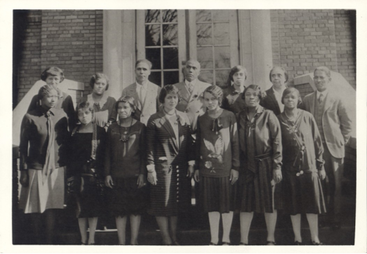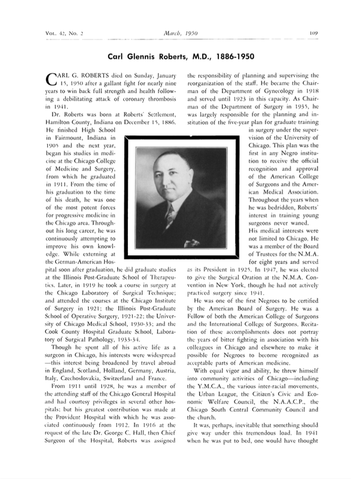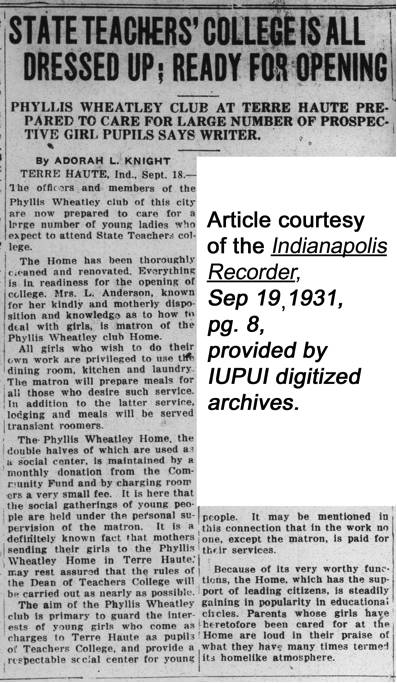This article is reprinted with permission from the Journal of the National Medical Association, written by Charles R. Drew, MD, March 1950, Vol. 42, No.2, pages 109-110
|
This is the second in a series of articles about people who have an association with Roberts Settlement. Please share your stories, anecdotes or personal recollections about ancestors or descendants so that their experiences are documented and become a part of the archives at Roberts Settlement. If you have an idea but need assistance in getting started please contact l[email protected] for more information. Working together collectively, our rich history will be preserved for future generations!  Knight is in the back row, second from the right (ca. 1926). Knight is in the back row, second from the right (ca. 1926).Photo courtesy The Vigo County Public Library, from the collection: “Photographs from A Selected History of the Lincoln School.” Education has long been valued at Roberts Settlement and in the early beginnings teachers primarily came from within the community. After instructing at Roberts Settlement, several educators moved on to larger cities and gained prominence in their professions in schools located in the Midwest. One of these teachers was Adorah L. Knight. She was born about March 1860 in Cincinnati, Ohio to Eliza (Mason) of Ohio and George Knight of Virginia and the youngest of three siblings (Margaret and George E.). It was the second marriage of their father, George, whose profession was a plasterer. Following George’s death in 1869, the family moved with their mother to Campbellstown, Ohio on the southwestern border of Ohio and eventually settled in Muncie, Indiana where Adorah received most of her primary and secondary education. She became the first African-American woman to graduate from Muncie High School in 1879. Her first teaching experiences were in the Knightstown and Spencer, Indiana area schools. (At that time in history, it was not essential for teachers to have the stringent educational requirements that are mandated today. Although prerequisites in this country changed over time, early teaching was viewed by many as an innate talent and formal training was not necessary). After the death of their mother, Adorah and her brother, George, eventually relocated to Hamilton County to reside with Margaret, the eldest of the children, who was by then the wife of Eli N. Roberts, a farmer at Roberts Settlement. By 1880, George, age 22, worked as a farm laborer and Adorah, age 19, as a teacher at Roberts Settlement while they lived with Margaret and Eli on their farm. In 1888, the acquisition of a post secondary education took Adorah to Indiana State Normal School (Indiana State University) located in Terre Haute, Indiana which was well known for educating teachers. Around 1900, George acquired his own farm at Roberts Settlement. Adorah was working as a teacher in Terre Haute at that time and returned in the summers to the countryside to reside with her brother in their home located east of the chapel. Nearby neighbors were the families of brother-in-law, Eli N. Roberts, Eli’s brother, William Penn Roberts and Albert Walden. For nearly forty years Adorah was an educator and spent most of her life teaching primary grades at the Lincoln School, an all Negro school in Terre Haute. In addition, she served as a principal at Dunbar School. This school was the first tax supported “colored” school in Terre Haute, established in 1869 after the amendment to fund separate schools for “colored” children in Indiana was passed. Miss Knight was also one of the first teachers and second principal at Booker T. Washington School, established in 1887 in District 10 which was located in the southeast area of Terre Haute. Return stays to the settlement in the summer included participating in local community involvement. She organized an annual Children’s Day Program each June collaborating with Sunday school teachers and the children at the church. The Roberts Settlement Homecoming Association elected her secretary July, 1927. Alongside Reverend L.N. Gilliam, she was a featured speaker, at a Mother’s Day program held at Bethel A.M.E. Church, Noblesville, on May 13, 1934. February 4, 1938, Adorah L. Knight passed away at Roberts Settlement and is buried in the cemetery behind the chapel alongside her brother, George, who preceded her in death circa 1928. She will not only be remembered for her dedication to the education of children but also revered for her civic activism in improving the conditions of the African-American youth in her community.
It was the desire of Milton and Pauline Roberts Wallace Baltimore to preserve the heritage of Roberts Settlement. They loved the church, and they hoped that "future generations would maintain, preserve, and cultivate a sense of pride and memory of our unique history." Therefore, in September 2002 the children of Milton and Pauline requested a timeline be developed for their parents honor and memory.
Click the "Timeline" button below to see the document that was compiled. The timeline places the events of Roberts Settlement within the context of nation- and world-wide events. |




 RSS Feed
RSS Feed